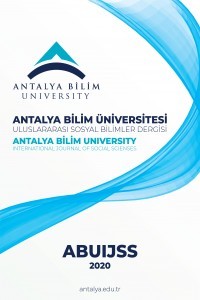REKLAM YOĞUNLUĞUNUN PAZARA GİRİŞ STRATEJİSİNE ETKİSİ ÜZERİNE BİR DEĞERLENDİRME
Küreselleşme şirketlerin yabancı pazarlara yönelmesinde etkili olmuştur. Bu çok uluslu şirketler yabancı bir ülkeye girerken çeşitli faktörleri değerlendirmektedir. Bu bağlamda verilmesi gereken önemli bir karar pazara giriş stratejisidir (giriş modu tercihi). Buna ek olarak reklam yoğunluğu da pazara giriş stratejisini etkileyebilecek önemli bir faktördür. Bu nedenle, reklam yoğunluğunun pazara giriş stratejisine olan tesiri üzerine bir analiz yapmak önem taşımaktadır. Bu çalışmanın amacı reklam yoğunluğunun pazara giriş stratejisine olan etkisi konusunda bir değerlendirme yapmaktır. Belirtilen incelemeyi gerçekleştirebilmek için ilgili konudaki altı makale seçilmiştir. Yapılan değerlendirme sonucunda literatürde tutarsız bulguların olduğu gözlemlenmiş olup, konu ile ilgili detaylar makalede tartışılmıştır. Tutarsızlıklara rağmen, genel anlamda, reklam yoğunluğu arttıkça çok uluslu şirketlerin tamamına sahip olunan bağlı ortaklık ile yabancı pazara giriş yapma ihtimalinin arttığı çıkarımı yapılabilmektedir.
Anahtar Kelimeler:
Pazara giriş stratejisi, ortak girişim, tamamına sahip olunan bağlı ortaklık, reklam yoğunluğu, pazarlama
AN EVALUATION OF IMPACT OF ADVERTISING INTENSITY ON ENTRY MODE CHOICE
Globalization has led companies to expand into foreign markets. These multinational enterprises (MNEs) consider diverse factors when entering a foreign country. One of the important decisions the MNEs make is the entry mode choice. Additionally, advertising intensity can be another important factor that may affect the entry mode choice. Therefore, it is important to make an analysis regarding the effect of advertising intensity on entry mode choice. Accordingly, the aim of this study is to make an evaluation regarding the impact of advertising intensity on entry mode choice. Six articles were chosen that are related to this topic to make a such investigation. The result of the evaluation showed that there are some inconsistent findings in the literature that are discussed in the paper. Apart from the inconsistencies, it can be stated that as the advertising intensity increases, the MNEs may choose wholly owned subsidiary to enter a foreign market.
Keywords:
Entry mode choice, joint venture, wholly owned subsidiary, advertising intensity, marketing,
___
- Anand, J. & Delios, A. (2002). Absolute and relative resources as determinants of international acquisitions. Strategic Management Journal, 23, 119–134.
- Chen, S.-F. S. & Hennart, J.-F. (2002). Japanese investors’ choice of joint ventures versus wholly-owned subsidiaries in the US: The role of market barriers and firm capabilities. Journal of International Business Studies, 33(1), 1-18.
- Cheng, Y.-M. (2006). Determinants of FDI mode choice: Acquisitions, brownfield, and greenfield entry in foreign markets. Canadian Journal of Administrative Sciences, 23(3), 202-220.
- Fan, D. & Xiao, C. & Zhang, X. & Guo, Y. (2021). Gaining customer satisfaction through sustainable supplier development: The role of firm reputation and marketing communication. Transportation Research Part E, 154, 102453.
- Fladmoe-Lindquist, K. & Jacque, L. L. (1995). Control modes in international service operations: The propensity to franchise. Management Science 41(7), 1238–1249.
- Gatignon, H. & Anderson, E. (1988). The multinational corporation’s degree of control over foreign subsidiaries: An empirical test of a transaction cost explanation. Journal of Law, Economics, Organization, 4(2), 305–336.
- Gilroy, B. M. & Lukas, E. (2006). The choice between greenfield investment and cross-border acquisition: A real option approach. The Quarterly Review of Economics and Finance, 46(3), 447-465.
- Gomes-Casseres, B. (1989). Ownership structures of foreign subsidiaries: Theory and evidence. Journal of Economic Behavior and Organization, 11, 1–25.
- Hennart, J.-F. (1988). A transaction costs theory of equity joint ventures. Strategic Management Journal, 9(4), 361-374.
- Hennart, J.-F. (1991). The transaction costs theory of joint ventures: An empirical study of Japanese subsidiaries in the United States. Management Science, 37(4), 483–497.
- Hennart, J.-F. & Park, Y.-R. (1993). Greenfield vs. acquisition: The strategy of Japanese investors in the United States. Management Science, 39(9), 1054–1070.
- Hill, C. W. L. & Hwang, P. & Kim, W. C. (1990). An eclectic theory of the choice of international entry mode. Strategic Management Journal, 11(2), 117–128.
- Kumar, V. & Subramanian V. (1997). A contingency framework for the mode of entry decision. Journal of World Business, 32(1), 53-72.
- Li, Y. & Zhang, B. & Fan, D. & Li, Z. (2021). Digital media, control of corruption, and emerging multinational enterprise’s FDI entry mode choice. Journal of Business Research, 130, 247-259.
- Mariotti, S. & Marzano, R. & Piscitello, L. (2021). The role of family firms’ generational heterogeneity in the entry mode choice in foreign markets. Journal of Business Research, 132, 800-812.
- Singh, H. & Kogut, B. (1989). Industry and competitive effects on the choice of entry mode. Academy of Management Proceedings, 116-120.
- Tripathi, S. N. & Misra, D. & Siddiqui, M. (2020). Impact of advertising intensity on market risk of a firm: A study on the Indian consumer goods sector. Global Business Review, 21(6), 1376-1386.
- Tsang, E. W. K. (2005). Influences on foreign ownership level and entry mode choice in Vietnam. International Business Review, 14, 441-463.
- ISSN: 2717-8560
- Yayın Aralığı: Yılda 2 Sayı
- Başlangıç: 2020
- Yayıncı: Antalya Bilim Üniversitesi
Sayıdaki Diğer Makaleler
DUYGUSAL EMEĞİN BİREYLERİN DEĞİŞİME DİRENÇ OLGULARI ÜZERİNE ETKİSİ: MERSİN İLİ ÖRNEĞİ
Abdullah ÇALIŞKAN, Zeki ARSLAN, Özgür Uğur ARIKAN
ETİK İKLİM ALGISI VE ÖRGÜTSEL ETKİLERİ: SAĞLIK ÇALIŞANLARI UYGULAMASI
REKLAM YOĞUNLUĞUNUN PAZARA GİRİŞ STRATEJİSİNE ETKİSİ ÜZERİNE BİR DEĞERLENDİRME
